The Various Types of Truffles
There are many different varieties of truffles: the classified Tuber species are almost a hundred separate species, even if only a clear minority of them are considered edible. Most of them are in fact toxic or characterized by organoleptic properties which make them inapplicable in the kitchen.
In Italy the law allows the collection and sale of only nine species of truffle, which include all those considered edible. Among these nine, six are the main ones that compete for the market: in the next paragraphs we will one by one go into more depth about the characteristics, the areas and the harvesting periods.
How do you distinguish the different species of truffle?
The most common used method to identify a truffle species is the manual organoleptic analysis, carried out within a short time after the harvest. The different types of truffle are distinguished by a series of characteristics:
- The smell, which is unique for each type
- The taste, also peculiar for each type
- The appearance of peridio, which is the outer peel
- The appearance of the gleba, the fleshy inner part
- The state of maturation, which varies from species to species
A method, which is only used very rarely, is the laboratory analysis. With this method the truffle spores are being located by biomolecular analysis techniques.
The most popular types of truffle
The following six species of truffle are the most sought-after truffles on the market:
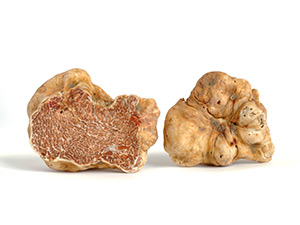
White Alba Truffle
This white truffle also known as Tuber Magnatum Pico is the truffle par excellence. It sprouts and grows only in Istria and Piedmont, where it is called the Alba Truffle. It lives in symbiosis with oaks, willows, linden and poplars, but it can also be found by black hornbeams and hazelnut trees. Their appearance is globular, with irregularities on the peridio whose surface is slightly velvety. The colour varies from cream to ochre and remains the same even when fully ripe. The gleba is white and greyish-yellow marbled with white veins. It is extremely aromatic, reminiscent of the smell of Parmesan cheese. It requires a soft, moist soil with good ventilation. It is usually harvested between October and December.
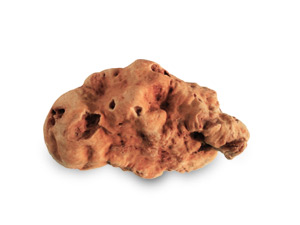
Bianchetto Truffle
The Bianchetto truffle, Marzuolo or Tuber Borchii Vittadini is widespread throughout the Italian peninsula. It has similar characteristics to the white Alba truffle because it has an uneven peridio, is smooth and off-white. When the truffle reaches maturity it becomes dark both inside and outside. It also differs from the more prized variant for its aroma: soft at the beginning, tending to take on strong garlic tones afterwards. As a result its commercial value is lower than the Alba truffle. It prefers calcareous soils and deciduous woods such as oaks, poplars, beech trees, hazelnut plants, willows, linden or conifers such as larches, cedars, firs and some species of pine. Harvesting takes place between January and the end of April.
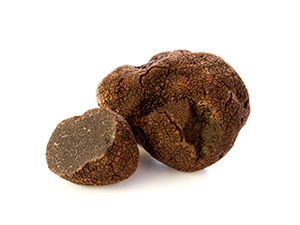
Fine Black Truffle
The fine black truffle or Tuber Melanosporum Vittadini, also known as the truffle of Norcia, Spoleto or truffle de Perigord. The peridium is quite homogeneous, the surface is blackish brown with rust red shades, the gleba is clear with light and thin veins. It has a roundish shape with warts or lobes. The scent is pleasantly intense, aromatic and fruity. It prefers hills and mountains with little vegetation. It lives in symbiosis with oaks, linden, hazelnuts, black hornbeams and rockrose plants. After the white Alba truffle, this species is the most prized. Usually the harvest is between December and mid-March, but regional administrations determine the exact period for harvest each year. It is widespread in Italy, Spain and France.
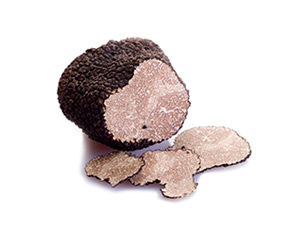
Black Summer Truffle or Scorzone
The black summer truffle, Scorzone or Tuber Aestivum Vittadini resembles the fine black truffle, but it stands out with gleba that has a dark yellow colour. The surface has pointed warts, the smell is delicate. This variety can reach remarkable dimensions. It grows in clayey and sandy soils, from the plain up to 1000 meters. Depending on the altitude, it can be found in symbiosis with oaks, hornbeams, beeches, hazelnuts, poplars, pines or hazels. Harvesting takes place between mid-May and the end of October.
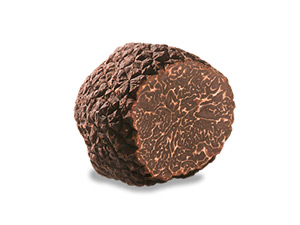
Black Winter Truffle
The black winter truffle or Tuber Brumale Vittadini is easily confused with fine black truffles. The surface is blackish-brown with small warts, while the gleba is dark with marble veins. The smell is intense and persistent with musky tones, the nutmeg variant reminisces of the famous spice itself. It can be found in the vicinity of plants such as oak, downy oak, beech, holm oaks, black pines, larches, black and white hornbeams or hazelnut plants. Its economic value is half that of the fine black truffle. The time for the harvest spans from January to April.
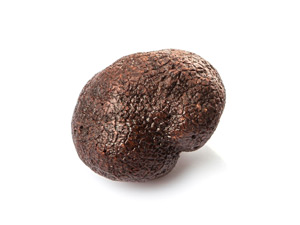
Smooth Black Truffle
The smooth black truffle or Tuber Macrosporum Vittadini is the least known and least commercialized type of truffle, but it still is one of the most appreciated. It has a smooth surface and slightly gibbous. The smell is very distinct and pleasant. This species loves oaks, poplars, linden, willows, hazelnuts and black hornbeams. The harvest period is between July and the end of December.
